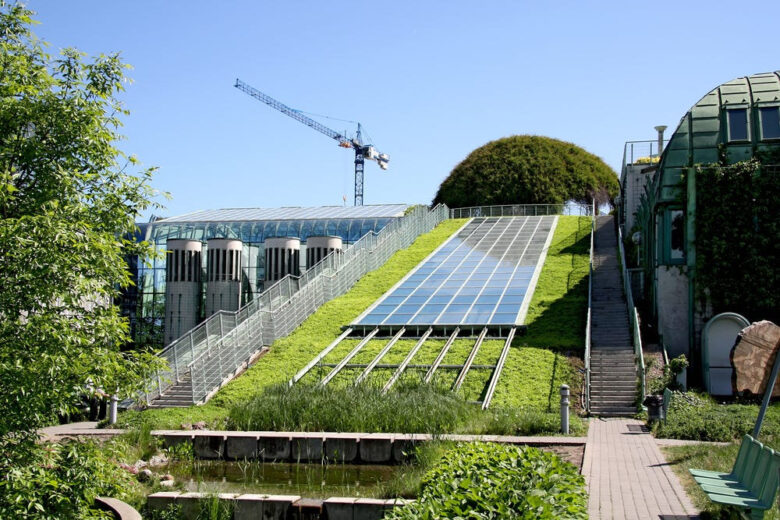Today, sustainability is more than just a word; it’s a necessity. As the problems caused by climate change increase, the construction industry is undergoing major changes. Green building techniques are becoming increasingly popular, not only because people care about the environment but also because they contribute to better, cleaner, and more efficient buildings. Today, both private homeowners and large developers are looking for new ways to increase energy efficiency and reduce their impact on the environment.
New green technologies are changing the way we build cities. These technologies include smart materials and advanced design systems. Whether you’re a construction worker, an engineer, or just someone who wants to live a greener life, it’s important to stay informed. In this article, you’ll learn about seven groundbreaking green building technologies that are actively shaping the future of architecture and urban planning.
1. Solar Roof:
Solar roofs aren’t just an idea for the future; they’re already a real solution in modern buildings. These solar systems incorporate lightweight roof tiles, which are more stylish than regular roofs, into their design. The old panels were bulky, but the new ones are thin, beautiful, and energy efficient. These roofs use solar energy to power homes and businesses, reducing the need for polluting fuels.
With many cities offering tax breaks and energy credits, the return on your investment in a solar roof is better than ever. They’ll cut your energy bills and raise your home’s resale value. Going green isn’t the only reason to install a solar roof; it’s also a smart way to save money and achieve energy independence. As technology improves, solar design is likely to change even more. Materials will become lighter and more efficient, and will be used in more building applications than just roofs.
2. Green Insulation Materials:
Fiberglass and foam are common traditional insulation materials, but they often contain harmful chemicals and are energy-intensive to produce. Green insulation changes all that. Using recyclable, reusable, or biodegradable materials provides the same or better thermal insulation than conventional insulation. Examples include cellulose (made from recycled paper), wool, and even jeans. These eco-friendly options maintain proper temperatures, reduce heating and cooling costs, and improve indoor air quality.
They’re also easier to install and less likely to harm your skin or lungs. As people become more aware of indoor pollution and its harmful effects on health, green insulation is quickly becoming the go-to choice. It allows homes to use less energy and be warmer in the winter and cooler in the summer. As regulations tighten and people become more aware of their health and energy conservation, green insulation could become the norm.
3. Cool Roof:
In warm places, regular roofing materials can warm a home, but cool roofs change everything. Reflective materials form these roofs, reflecting sunlight off the roof rather than absorbing it. This keeps the interior cooler, reducing the amount of air you need to cool and lowering your energy bills. There are several types of cool roofs, including coatings, membranes, and tiles. These can be applied to both new and existing roofs. They reduce the heat absorption and help reduce the heat island effect, a major problem in areas with many buildings. In addition, cool roofing materials tend to last longer because they expand and contract less with temperature changes. Environmental regulations encourage greener urban development, so cool roofs are not only a good idea but are increasingly becoming a legal requirement in some areas.
4. Smart Glass Windows:
Electrochromic glass, also known as ‘smart glass,’ is a dynamic window technology that can change its tint depending on temperature, sunlight, or even commands from a smartphone. These windows let in more natural light, reduce glare, and remove the need for artificial lighting and temperature control. The result is significant energy savings, especially in commercial buildings with many windows. Smart glass can block UV rays and regulate indoor temperatures, making people feel more comfortable without the need for blinds or curtains.
You can program some systems to transition from clear to dark, ensuring privacy and conserving energy. As building automation becomes more common, smart glass is likely to become an essential part of homes and businesses. It is the perfect combination of beauty and functionality, helping architects and builders design buildings that are both beautiful and sustainable.
5. Prefabricated Modular Buildings:
Modular construction is not only convenient but also good for the environment. With this approach, building components can be manufactured off-site in a controlled environment and then assembled on-site. This approach can significantly reduce waste, speed up construction, and lower labor costs. Because the modules are made in a factory, it is easier to implement green practices such as using materials that use less energy, precision cutting, and reducing emissions.
Modular homes are also very environmentally friendly because they are simple to take apart and reassemble. Because they can be designed and expanded in many different ways, they are ideal for homes, businesses, and even schools. Because there is less disturbance on the ground, there is less noise and air pollution in the city. As cities grow and more people want to live there, modular construction is developing into a scalable, environmentally friendly way to maintain high quality and reduce environmental impact.
6. Green Concrete Alternatives:
It’s one of the most common architectural elements, but also one of the dirtiest. Here are the options for green concrete. These new materials, such as fly ash, slag, or recycled concrete aggregates, can be used to replace traditional cement, which emits large amounts of carbon dioxide during the production process. Some even use carbon capture systems that absorb CO₂ over time.
The result is that materials last longer, perform better, and have a lower impact on the environment. By using industrial waste, green concrete retains all the benefits of conventional concrete while supporting the concept of the circular economy. As construction companies continue to investigate how to meet pollution targets and reduce their carbon footprint, green concrete is becoming the new standard for eco-friendly construction.
7. Rainwater Harvesting System:
Water conservation is a major issue in modern construction, especially in areas that are often dry. Water from the roof is collected, filtered, and stored by a rainwater harvesting system. After proper treatment, you can use this water for plumbing, irrigation, and even drinking water. These systems reduce the strain on public water supplies and can significantly reduce utility costs. They also help regulate stormwater runoff, reducing the risk of flooding and soil erosion. The technology can be as simple as a bucket and a filtration system or as complex as a fully integrated network of sensors. Installing rainwater systems in buildings is not only smart, it’s necessary as the world’s water crisis worsens. It’s a smart way to make homes more self-sufficient and resilient in the face of climate change.
Conclusion:
The future of construction is smart, green, and exciting. These seven eco-friendly technologies aren’t fads; they’re plans for a better future. From solar-paneled roofs to rainwater harvesting systems, these systems help reduce the damage our homes do to the environment. Embracing these new ideas isn’t just good for the environment; it’s good for the economy. It’s good for your business and your health. As building codes change and people become more environmentally conscious, using green technology will no longer be an option; it’s to be expected. Whether you’re a builder, a homeowner, or someone who cares about the environment, now is the perfect time to build with purpose. Let’s build a future together where every contribution helps heal the planet.
FAQs:
1. What is green building technology?
Green building technology refers to environmentally friendly and energy-efficient construction methods that utilize products and systems designed to minimize environmental impact.
2. Is green building technology expensive?
Green technologies may be pricier up front, but in the long run, they can save you money by reducing your energy bills and maintenance expenses.
3. Can I add green building technologies to an existing home?
Yes, existing buildings can be retrofitted with various technologies, such as solar panels, better insulation, and rainwater harvesting systems.
4. Can green buildings sell for more money?
Certainly. Homes and buildings with green permits or technologies are often more expensive because they attract buyers who want to save energy and protect the environment.
5. Does the government support green buildings?
Many governments offer tax breaks, subsidies, and rebates to people who install green technology. These help cover the initial costs.




